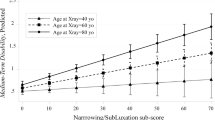Abstract
In previous studies we observed a proximo-distal gradient of lesion frequencies along the limb, with the distal joints being the most often affected. This suggests an associated effect of environmental factors on the most exposed joints. On a population of 820 children (mean age 13 years) of endemic areas distributed in groups of healthy and severity stages I to III of KBD (Kashin-Beck disease), the effects of different working activities were studied. Heavy work like that of a ploughman were compared to light physical work, e.g. school children, and exposure to cold and history of frostbite were also considered. The most severe stages, II and III, were present in 72% of the ploughman vs. 29% of the schoolchildren, 70% of the shepherds vs. 30% (p < 0.001) of the schoolchildren, and in 65% of the shepherds working in winter vs. 40% of those working in the other seasons (p < 0.001). In the group with history of frostbite, 58% present the severest stages vs. 40% without (p < 0.001). The results confirm a highly significant relation between microtrauma and cold and the severity of the KBD alterations.
Résumé
Dans nos précédentes études, nous avions observé un gradient de fréquence proximo-distale des lésions le long des membres, les articulations distales étant les plus souvent atteintes. Ceci suggère un effet associé des facteurs environnementaux sur les articulations les plus exposées. Sur une population de 820 enfants (âge moyen 13ans) provenant de régions endémiques et distribués en groupes sains et de stades de gravité de la maladie de KASHIN-BECK s´échelonnant de I à III, nous avons étudié les effets de différents types d´activités. Les travaux lourds, comme celui de laboureur, ont été comparés à une activité plus légère telle que celle d´écolier. Les stades les plus sévères (II et III) sont présents chez 72% des laboureurs contre 29% chez les écoliers, chez 70% des bergers contre 30% des écoliers (p<0.001) et chez 65% des bergers travaillant en hiver contre 40% chez ceux travaillant pendant les autres saisons (p<0.001). Dans le groupe présentant des antécédents de gelure, 58% présentent les stades les plus sévères contre 40% dans le groupe sans antécédents (p<0.001). Ces résultats confirment une relation très hautement significative entre les microtraumas et l´exposition au froid et la sévérité des lésions de la maladie de Kashin-Beck..








Similar content being viewed by others
References
Allander E (1994) Kashin-Beck disease. An analysis of research and public health activities based on a bibliography. Scand J Rheumatol (23):1849–1992
Chasseur C, Suetens C, Nolard N, Begaux F, Haubruge E (1997) Fungal contamination in barley and Kashin-Beck disease in Tibet. Lancet 350:1074
Chasseur C, Suetens C, Michel V, Mathieu F, Begaux F, Nolard N, Haubruge E (2001) A 4-year study of the mycological aspects of Kashin-Beck disease in Tibet. Int Orthop 25(3):154–159
Chasseur C, Suetens C, Begaux F, Haubruge E, Wangla R, Rinchen L, Wangdu L, Claus W, Mathieu F (2008) The mineral deficiency hypothesis. In: Malaisse F, Mathieu F (eds) “Big Bone Disease”. Presse Agro de Gembloux, pp 101–103
Chasseur C, Lognay G, Suetens C, Rapten S, Gillet P, Kanyandekwe P, He L, Drolkar P, Wangla R, Begaux F, Haubruge E, Rinchen L, Wangdu L, Claus W, Mathieu F (2008) The fungal hypotheses. In: Malaisse F, Mathieu F (eds) “Big Bone Disease”. Presse Agro de Gembloux, pp 85–99
Haubruge E, Chasseur C, Debouck C, Begaux F, Suetens C, Mathieu F, Michel V, Gaspar C, Rooze M, Hinsenkamp M, Gillet P, Nollard N, Lognay G (2001) The prevalence of mycotoxins in Kashin-Beck disease. Int Orthop 25(3):159–162
Hinsenkamp M, Rippens F, Begaux F, Mathieu F, de Maertelaer V, Lepeire M, Haubruge E, Chasseur C, Stallenberg B (2001) The anatomical distribution of radiological abnormalities in Kashin-Beck disease. Int Orthop 25(3):142–147
Hinsenkamp M, Mathieu F, Begaux F, Samdrup T, Stallenberg B (2008) Radiologic study. In: Malaisse F, Mathieu F (eds) “Big Bone Disease”. Presse Agro de Gembloux, pp 57–59
La Grange M, Mathieu F, Begaux F, Durand MC (2001) Kashin-Beck disease and drinking water in Central Tibet. Int Orthop 25(3):167–169
Mathieu F, Hinsenkamp M (2008) Kashin-Beck disease. In: Malaisse F, Mathieu F (eds) “Big Bone Disease”. Presse Agro de Gembloux, pp 11–18
Mathieu F, Begaux F, Lan Z, Suetens C, Hinsenkamp M (1997) Clinical characteristics of Kashin-Beck disease in Nyemo Valley, Tibet. Int Orthop 21(3):151–156
Moreno-Reyes R, Suetens C, Mathieu F, Begaux F, Zhu D, Rivera MT, Boelaert M, Neve J, Perlmutter N, Vanderpas J (1998) Kashin-Beck osteoarthropathy in rural Tibet in relation to selenium and iodine status. New Engl J Med 339(16):1112–1120
Moreno-Reyes R, Mathieu F, Boelaert M, Begaux F, Suetens C, Rivera MT, Nève J, Perlmutter N, Vanderpas J (2003) Selenium and iodine supplementation of rural Tibetan children affected by Kashin-Beck osteoarthropathy. Am J Clin Nutr 78(1):137–44
Pasteels JL, Liu F-D, Hinsenkamp M, Rooze M, Mathieu F, Perlmutter N (2001) Histology of Kashin-Beck lesions. Int Orthop 25(3):151–154
Sokoloff L (1989) The history of Kashin-Beck disease. NY State J Med 89(6):343–351
Acknowledgements
We would like to ackowledge the KBD Foundation.
Author information
Authors and Affiliations
Corresponding author
Rights and permissions
About this article
Cite this article
Hinsenkamp, M., Mathieu, F., Claus, W. et al. Effects of physical environment on the evolution of Kashin-Beck disease in Tibet. International Orthopaedics (SICOT) 33, 1085–1088 (2009). https://doi.org/10.1007/s00264-009-0738-9
Received:
Revised:
Accepted:
Published:
Issue Date:
DOI: https://doi.org/10.1007/s00264-009-0738-9




